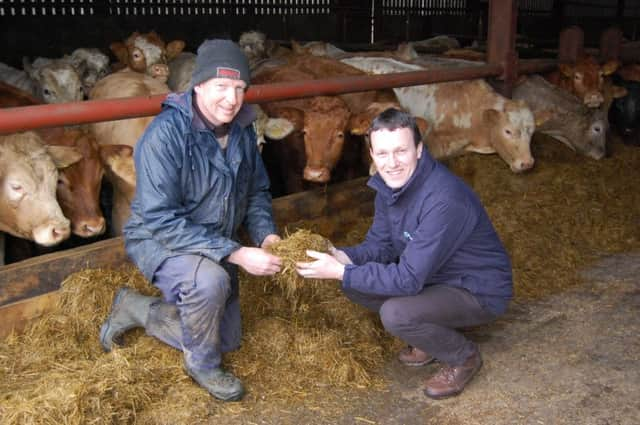Making better silage leads to faster finishing on Tyrone beef farm


“I normally finish 200 cattle out of the house from January through until, the end of April,” Alastair explained.
“But between young stock and those cattle on their finishing diets, there would normally be around 300 cattle in the sheds over the winter months. I have two sons, who are still at school. But both are extremely interested in the cattle.”
Advertisement
Hide AdAdvertisement
Hide AdAlastair is totally committed to sourcing only high quality suckler weanlings for the business.
“These are the types of cattle that have the potential to grow well and produce finished cattle of the quality that will secure the best prices available. All the finished cattle are sold deadweight.”
Alastair has long recognised the importance of making high quality silage for his beef enterprise. Normally, two cuts are taken- the first of 80 acres: the second of 40 acres.
Traditionally, he has used his own silage making equipment, with a forage wagon the preferred option when it comes to picking up the mown grass and bringing it to the silo.
Advertisement
Hide AdAdvertisement
Hide Ad“The forage wagon system fits in well, as it does not require lots of additional labour to operate. I have a man working with me part time on the farm and between us we can cut and ensile 80 acres of grass within three days without putting either of us under pressure.”
Alastair normally takes two cuts of silage. The grass is cut, wilted for 24 hours with the forage cut to a chop length of around 10 cm courtesy of the wagon.
“We try to make the silage making operation as simple and as straightforward as possible,” he stressed.
Last spring Alastair purchased a new Pottinger Europrofi 4500 forage wagon. It was a decision that had a number of additional, and very beneficial, consequences for his silage making processes across the board.
Advertisement
Hide AdAdvertisement
Hide Ad“In the first instance the purchase of the new wagon allowed me to have a liquid inoculant applicator mounted within the system,” he confirmed.
“I worked closely with Provita’s Tommy Armstrong to both source a system that suited the company’s Advance+ liquid inoculant and to calibrate it properly. Up to that point, I had never used an inoculant, or a silage additive of any kind.
“The decision was also taken to bring back our first cut date by a fortnight. Up to last year I normally cut silage during the first week of June. However, last year I opted for a date towards the end of May.”
And the results achieved speak for themselves. Analysis results confirm that last year’s first cut an average dry matter of 26%, an ammonia value of 5, an ME value of 12.0 MJ/Kg DM and D value of 75.
Advertisement
Hide AdAdvertisement
Hide AdProvita’s Tommy Armstrong was a recent visitor to the Doran farm.
“The better the quality of the silage presented to cattle, the higher the level of performance achieved,” he explained.
“Better quality forages also provide livestock farmers with greater scope to reduce meal feeding rates while, at the same time, maintaining very high levels of performance from their animals.”
Alastair is quick to confirm that silage intakes are well up on the farm this year.
Advertisement
Hide AdAdvertisement
Hide Ad“The finishing cattle are currently achieving liveweight gains of around one kilo per day.
“Normally growth can stall at this time of the year. What has particularly impressed me is the fact that the cattle are continuing to grow. And I put this down to the excellent quality silage available them to this year.
“In the past the finishing cattle left in the shed during April would be much harder to get over the line. But its the opposite this year.”
Tommy Armstrong pointed out that the pay-off secured by farmers striving to improve the quality of the silage they make is immense.
Advertisement
Hide AdAdvertisement
Hide Ad“And it can be achieved quite easily by committing to cut grass that little bit earlier and using a proven inoculant, such as Advance+, which will significantly improve the fermentation characteristics achieved within the clamp,” he said.